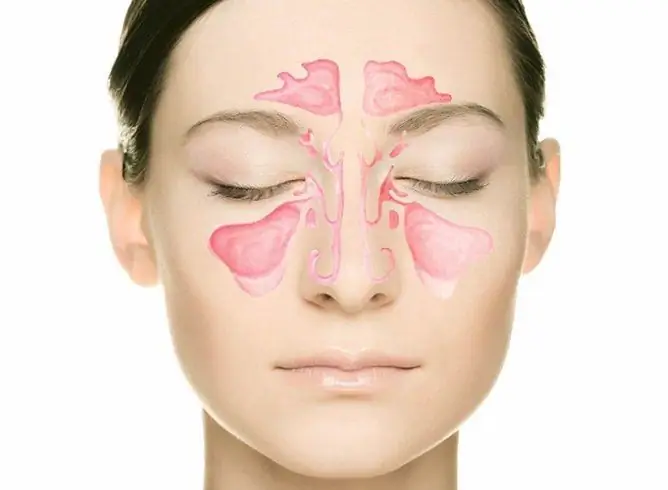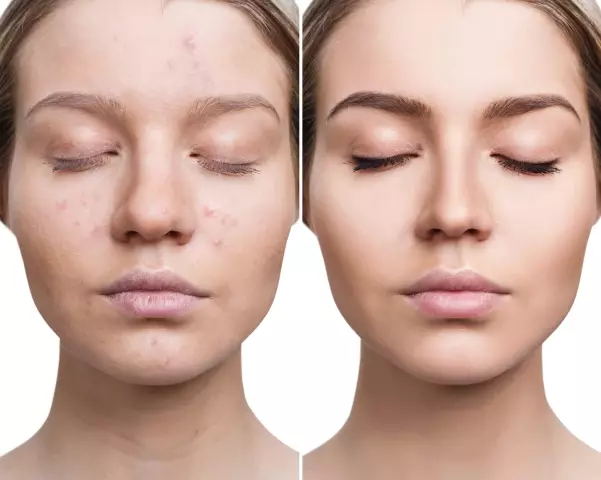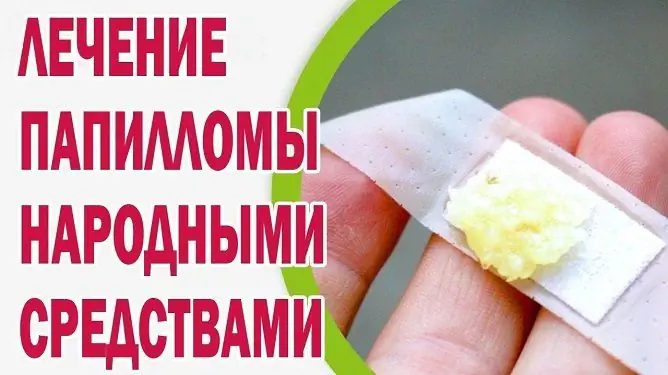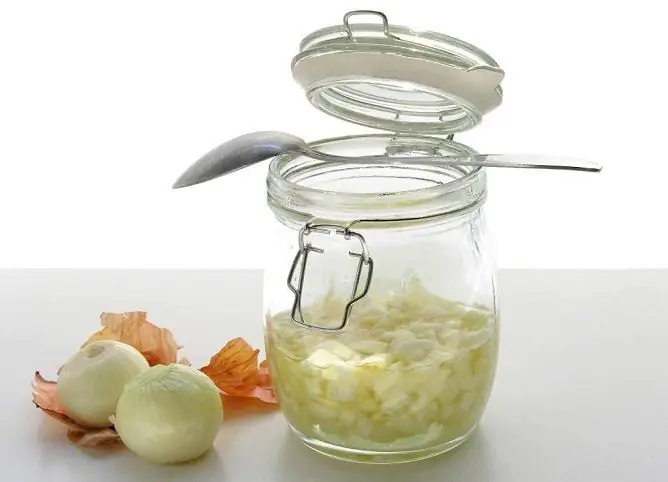- Author Rachel Wainwright [email protected].
- Public 2023-12-15 07:39.
- Last modified 2025-11-02 20:14.
Treatment of sinusitis with folk remedies: the most effective methods
The content of the article:
- The reasons for the development and the main symptoms of sinusitis
-
Treatment
- Laundry soap
- Horse chestnut
- Oils
- Aloe
- Cyclamen
- Propolis
- Means for rinsing the nose
- Means for oral administration
- Video
Sinusitis is a disease in which inflammation affects the sinuses in the upper jaw. It can be unilateral or bilateral, and occur with damage to other paranasal sinuses.

Sinusitis affects the sinuses located in the upper jaw
The disease can occur in both adults and children. Along with classical medicine, traditional methods of treating sinusitis (as auxiliary) are often used at home.
The reasons for the development and the main symptoms of sinusitis
The main causes of the disease:
- upper respiratory tract infections;
- allergic rhinitis;
- defects in the anatomical structure of the nose;
- deep caries;
- polyps in the nose;
- damage to the nasal septum;
- injuries in the nose.
The following symptoms may indicate the development of sinusitis:
- pain in the area of the affected sinus, which intensifies in the evening;
- foul-smelling purulent nasal discharge;
- weakness;
- violation of the sense of smell;
- severe headache that worsens when bending forward;
- increased body temperature.
Treatment
Traditional methods of treating sinusitis are quite popular and can be used as an auxiliary therapy. They include decoctions and tinctures of medicinal plants, bee products, pharmaceutical ointments and solutions, as well as other products.
Laundry soap
For the treatment of sinusitis, ordinary laundry soap that does not contain additives can be used. It consists of natural animal fats, alkalis, zinc paste and rosin. The soap has a disinfecting, irritating and drying effect. Once in the nose, soap-based products improve the drainage of pus, helping to cleanse the sinuses.

One of the means used in the treatment of sinusitis is laundry soap.
To prepare the product, rub a small amount of soap on a fine grater. A teaspoon of shavings is mixed with the same amount of alcohol, bee honey and aloe juice. The mixture is heated in a water bath, stirring until complete dissolution.
Previously, a small turunda is prepared from gauze, on which the product is applied. The patient sits down, leaning forward slightly and inserts it into the nose. The action develops within 5 minutes, as a result of which the pus begins to actively withdraw.
After 10-15 minutes, the turunda is taken out. The procedure is repeated the next day. To improve the condition, 2-3 applications are usually sufficient.
Horse chestnut
Chestnut fruits for sinusitis are considered one of the most effective remedies. They can help remove pus filling your sinuses, improve drainage, and reduce swelling. Several fruits should be placed in a glass of warm salted water and left until they sink to the bottom.
Then, using a sharp knife, a narrow triangle is cut out of the core of the chestnut, and a safety pin is threaded into its wide edge (in order to make it easier to hold).
The first part of the procedure is steaming, for this you need to do steam inhalation (breathe in a decoction of eucalyptus). Then sunflower oil is applied to the surface of the chestnut and injected into the affected nostril.
You need to sit down, leaning forward a little, and wait 10-15 minutes. During this period, the contents of the maxillary sinuses will begin to come out. Periodically, the chestnut is removed from the nose and, pinching one nostril, the contents of the other are blown out.
With bilateral sinusitis, the sinuses are cleaned alternately. The procedure is performed once a day for 3-4 days. After cleansing the nose, anti-inflammatory drops can be applied. In addition to pharmacy products, use red beet juice. It is preliminarily diluted with water in a ratio of 1: 1 and 3-4 drops are dripped into the nose at least three times a day. The combination of these methods helps to quickly cure sinusitis.
Oils
The means that help to cure sinusitis include oils. Traditional methods of treatment include sea buckthorn, rosehip, eucalyptus or tea tree oil. They have antiseptic and anti-inflammatory effects, contribute to the rapid relief of inflammation and enhance the effectiveness of the drugs used.

Rosehip oil has an antiseptic and anti-inflammatory effect and can be used as an adjuvant for sinusitis
Rosehip or sea buckthorn oils can be made at home. For this, 100 g of fresh fruits are crushed, poured with the same amount of olive oil and left for three days in a dark place. Then the product is passed through a sieve (so that the contents are homogeneous), the finished product is stored in the refrigerator. Warmed oil is instilled into the nose, 2-3 drops in the morning and evening.
Ready-made oils can be purchased at the pharmacy. Combined oil-based drops are also used to treat the disease. To prepare such a remedy, add 2 drops of tea tree, eucalyptus and juniper oils to 20 ml of corn, olive or linseed oil. Apply three times a day.
For the treatment of sinusitis, an ointment can be used, which is prepared on the basis of refined olive oil. For this, 100 ml of oil is heated in a water bath, and then 10 g of crushed beeswax is added.
At the next stage, 1/4 of the yolk is introduced into the solution (the egg must be boiled beforehand). Then the finished mixture is removed from the water bath and filtered. Poured into a glass container and stored in the refrigerator.
To treat the disease, thin turundas soaked in ointment are injected into the nose twice a day and left for half an hour. The procedure is carried out daily for a week.
Aloe
Aloe has many health benefits. It relieves inflammation well and helps to remove pus from the maxillary sinuses. In order for the aloe-based products to be as effective as possible, you need to use the plant at least two years old.

Aloe juice is used to remove pus from the maxillary sinuses
For cooking, you should cut off a few leaves, wrap them in paper and place them on the bottom shelf of the refrigerator for several days, since under such conditions the plant turns into a biostimulant. Then the leaves are washed and the juice is squeezed out. It is poured into a glass container and stored in a cool place. 2 drops drip into the nose at least three times a day.
To remove the contents of the maxillary sinuses, a mixture is prepared, which includes the juice of aloe and onion in a 1: 1 ratio. Then add a small amount of honey. The finished product is impregnated with turunda, which is injected into the nose and left for 1/4 hour. As a result, the nose is cleared of the contents, and the inflammatory process is reduced. The procedure is carried out once a day.
Cyclamen
Cyclamen root is one of the best remedies for the disease. Its extract is included in many pharmacy products used in the treatment of sinusitis. In order to prepare the medicine at home, the root must be thoroughly washed, dried with a paper towel and grated on the finest grater.

Cyclamen is a houseplant traditionally used for sinusitis
With the help of gauze, you need to squeeze out the juice, add it to olive oil (four parts oil - one part juice). The agent is quite aggressive and can cause burns to the nasal mucosa, therefore, it is not used in its pure form.
Three drops of the solution are dripped into each nostril. The contents of the sinuses begin to come out very actively. The procedure is carried out once a day for three days.
There are recipes in which ointments based on cyclamen and pharmaceuticals are used to cleanse the maxillary sinuses from the contents. For cooking, you must mix in equal amounts:
- cyclamen juice;
- Vishnevsky ointment;
- onion juice with honey;
- aloe juice.
The finished ointment is impregnated with a thin gauze tourniquet, which is placed in the nose for 15 minutes. The agent will draw out pus, thereby helping to cleanse the nose and eliminate the inflammatory process. According to patient reviews, the use of cyclamen-based products is one of the most effective methods of treatment.
Propolis
One of the most commonly used folk remedies in the treatment of sinusitis is propolis. The bee glue contains trace elements, vitamins and amino acids. It is used in the treatment of many diseases, including sinusitis. Propolis has antibacterial and anti-inflammatory properties.

Propolis is often used to treat sinusitis.
For rinsing the nose, a ready-made tincture can be purchased at the pharmacy. You can also do it at home. This will require 30 g of propolis, which is pre-crushed and poured with 70% alcohol in a volume of 100 ml. For a week, the agent is insisted in a dark place, shaking occasionally.
Means for rinsing the nose
For rinsing the nose with sinusitis, decoctions / infusions prepared on the basis of medicinal plants or special solutions can be used:
- Infusion from a mixture of plants. To prepare the infusion, take one teaspoon of chamomile flowers, calendula or sage leaves and pour 200 ml of water. The broth is boiled for 5 minutes, then covered with a lid and left to cool. The product is filtered and dripped into the nose 3-4 times a day with a pipette. It helps reduce inflammation.
- Propolis tincture. To prepare a solution for rinsing the nose, 1 teaspoon of the tincture is diluted in 100 ml of boiled water. Using a syringe, the solution is injected into the nose in the morning and in the evening.
- Multi-component solution. 1/2 teaspoon of sea salt, 20 ml of eucalyptus tincture and 2 drops of iodine are added to a glass of warm boiled water. To do this, pinch one nostril, and draw in liquid with the other. The procedure is repeated twice a day. It is antiseptic and can help reduce inflammation and improve sinus drainage.
- Hydrogen peroxide (hydrogen peroxide, H 2 O 2). This folk remedy is used to treat sinusitis in adults, as swallowing it can be hazardous to health. To prepare the solution, dissolve one teaspoon of peroxide in a glass with boiled chilled water. The patient needs to blow his nose, bend over the bathtub, pressing his head to his shoulder, and inject a portion of the solution into the upper nostril. If the procedure is carried out correctly, then it will pour out of the second nostril.
Nasal lavage is a rather serious procedure that requires caution, since if done incorrectly, fluid may enter the middle ear, which is fraught with the development of otitis media.
Means for oral administration
Against sinusitis at home, they use not only drops, ointments and rinsing, but also means for oral administration:
- A decoction of lavender, string, sage and chamomile. For cooking, you need to mix in the same proportion of herbs. 10 g of raw materials are poured into 2 liters of water and boiled in a water bath for 10 minutes. After the broth has cooled, it is filtered and divided into 4 portions. During the day, you need to drink 500 ml of the product in 2-3 doses. Treatment continues for at least two weeks;
- Infusion of viburnum bark, nettle leaves and St. John's wort. 2 parts of viburnum bark are mixed with one part of nettle leaves and the same amount of St. John's wort herb. 2 g of raw materials are poured with a glass of boiling water and allowed to brew for 40 minutes. Filter and drink in 2 doses;
- Tincture of viburnum, sea buckthorn, rose hips. A glass of ripe fruits of viburnum, sea buckthorn and rose hips are crushed using a blender, two glasses of honey are added and left overnight in the refrigerator. Then add 500 ml of vodka and leave for a week. Take a tablespoon three times a day before meals. Such a remedy improves the functioning of the immune system, which enables the body to quickly cope with the disease.
Folk remedies for sinusitis at home should be used only as an auxiliary treatment. If there is a suspicion of the development of a disease in a child, you should immediately seek the advice of a doctor.
Sinusitis is a serious medical condition that can lead to serious complications. The transition of the disease to a chronic form or the development of diseases such as meningitis or periostitis is possible. If within three days the treatment of sinusitis with folk remedies does not work, and the patient's condition does not improve, it is necessary to consult an otolaryngologist.
Video
We offer for viewing a video on the topic of the article.

Anna Kozlova Medical journalist About the author
Education: Rostov State Medical University, specialty "General Medicine".
Found a mistake in the text? Select it and press Ctrl + Enter.






